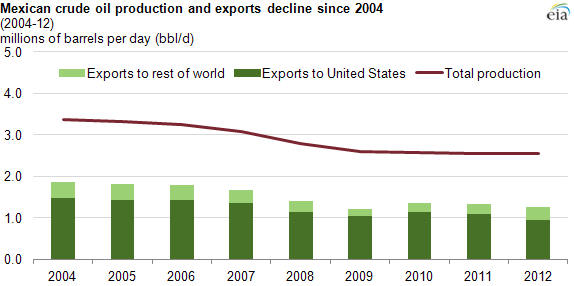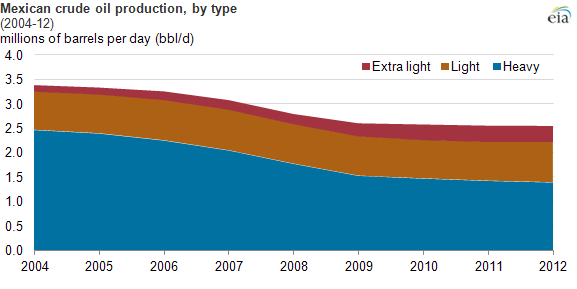
Mexico Week: Lower Mexican oil production contributes to lower crude oil exports to U.S.

This is the second in a series of five articles on U.S.-Mexico energy trade.
Republished May 15 to correct text.
Crude oil exports anchor the energy trade between Mexico and the United States. In 2012 Mexico was the world's ninth largest oil producer. The value of crude oil exports from Mexico to the United States reached $35.7 billion in 2012, having more than doubled since 2004. However, Mexico's crude oil production and exports to the United States have both fallen, with exports down to 0.97 million barrels per day (bbl/d) in 2012 from 1.48 million bbl/d in 2004. Last year was the first time since 1994 that annual exports of Mexican crude oil to the United States fell below 1 million bbl/d.
Mexico's share of total U.S. crude oil imports fell to 11% in 2012, down from 16% in 2003.
Typically, Mexico exports its heavier crude oils and keeps its lighter crude, mostly from southern regions, for its own refineries. More than 90% of Mexico's heavy crude oil production occurs in the Northeastern Marine production region (see map), and this is where 75% of Mexico's oil production declines have occurred. The heavy crudes are predominantly composed of the Maya variety, which state oil company Petroleos Mexicanos (Pemex) mainly produces from the Cantarell and Ku-Maloob-Zaap offshore oil fields, located along the coast of the Yucatan Peninsula.
Crude oil production trends in Mexico vary by grade and location. Mexico's production of heavy crude oil fell 46%, or 1.1 million bbl/d, from 2004 to 2012. However, Mexico's production of light and extra light crude oil rose 0.2 million bbl/d between 2004 and 2012, partially offsetting the heavy crude declines.

In 1938, Mexico nationalized its hydrocarbons, and its constitution continues to prohibit foreign companies from owning any portion of production. Throughout much of the world, and certainly in the United States, equity shares of hydrocarbon production are a significant incentive for companies to share the risk of production and, at the same time, provide technical expertise.
In 2008, Mexico's Congress enacted energy reform legislation to help address concerns related to Mexico's slow application of advanced exploration and production technologies and its declining oil production since 2004. The reforms retained Pemex ownership of all crude oil produced, but they allowed foreign companies to participate in the oil sector through service contracts. As a result, Pemex entered into a handful of partnerships, mostly concentrated in lower-risk production areas where there is a relatively greater likelihood of recovery. So far, partnerships have not included major international oil companies.

Note: Extra light crude oil defined as crude oil with an API density of above 38 degrees. Light crude oil defined as crude oil with an API density of between 27 and 38 degrees. Heavy crude oil defined as crude oil with an API density of 22 degrees or below, according to the Pemex glossary.
On Wednesday, Today in Energy will address Mexican crude oil and petroleum product trade with the United States.
For more information, see EIA's Country Analysis Brief for Mexico.
Tags: exports/imports, international, liquid fuels, map, Mexico, oil/petroleum